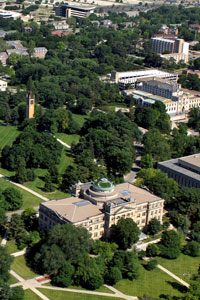Buildings & Grounds
 Iowa State could not function without the multitude of physical spaces provided to its students, faculty, staff and visitors. With a diverse array of settings, including classrooms, conference rooms, laboratories, offices and outdoor seating areas, it is of the utmost importance to university administration that these environments remain beautiful, functional, safe, sanitary and sustainable.
Iowa State could not function without the multitude of physical spaces provided to its students, faculty, staff and visitors. With a diverse array of settings, including classrooms, conference rooms, laboratories, offices and outdoor seating areas, it is of the utmost importance to university administration that these environments remain beautiful, functional, safe, sanitary and sustainable.
This commitment is driven by Leadership in Energy and Environmental Design (LEED), an internationally recognized certification system that grants buildings with sustainability achievement levels of Certified, Silver, Gold and Platinum through a third-party verification process managed by the US Green Building council. Iowa State's LEED journey began in 2008 when Morrill Hall received Silver to become the university's first LEED-certified building, as well as only the second LEED-certified building in all of Iowa. Due to the incredible success of the Morrill Hall project, in 2008 Iowa State also established a goal that all future construction and major renovation projects would achieve LEED Gold. With 23 LEED-certified buildings and counting, our university has the most LEED-certified buildings of any Regent institution.
However, LEED impacts more than the design, construction and renovation of buildings, spurring many campus partners to maintain sustainability initiatives of their own. For example, the university partnered with the City of Ames to establish a LEED-certified Intermodal Facility that serves as a central transportation hub connecting the campus with the greater community. Custodial Services at FPM as well as Dept of Residence and Athletics also use green chemicals to clean all campus buildings, while Campus Services has decreased its herbicide use by two-thirds in part to meet LEED standards related to outdoor entryways. Embracing LEED has created positive changes within numerous departments and programs, solidifying Iowa State's role as a pioneer and leader in its approach to physical spaces. Read on to learn more about the sustainable practices our university uses to maintain its buildings and grounds!
"By incorporating sustainable design principles into the planning and construction of buildings on campus, the built environment creates an enlightened learning experience for faculty, staff and students alike."
-Dan Sloan, University Architect